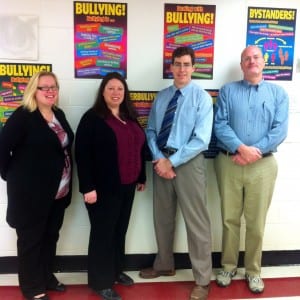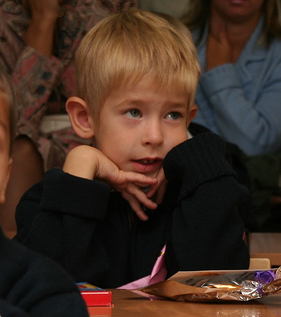Until recently, I hadn’t spent an inordinate amount of time pondering the impact of the transition from elementary school to high school on the psyche of our students here in Quebec. Although the tumble from “King or Queen of the Castle” in grade 6 to “Groundhog” in grade 7, may very well be considered an expected rite of passage, it is decidedly a difficult one for even the most self-assured 12 year old. Why am I thinking about this now, you ask? Well, because my very own flesh and blood started high school in September and I’ve been tagging along (emotionally) for the not altogether smooth ride.
It is purported that one of the ways in which schools can help students more successfully navigate the critical academic years from grades 5 to 9 is to implement organizational and instructional strategies that respond to the intellectual, emotional, physical, social and moral needs of early adolescents. A challenge…to say the least! According to the Association for Middle Level Education (formerly National Middle School Association), the most successful middle school models include variations of the following 5 key elements:
- Interdisciplinary teaming, whereby a core team of teachers work together with the same group of students
- Advisory programs
- Varied & differentiated learning opportunities
- Exploratory programs (such as intramural sports, music, student government, etc.)
- Transition programs (such as tours and orientation days)
Two weeks ago, I had the opportunity to see how an adapted middle school model works during my son’s grade 7 parent-teacher interview at Pontiac High School, in Western Quebec. Once escorted to the meeting by my son (weird), I quickly realized that what I was taking part in was not really an interview, nor was it at all about me. It was more of a discussion with my son, and each of his four core subject teachers, about his goals, his successes (both academic and other) and some of the challenges he was facing (again, both academic and other). Of course, I felt included and was encouraged to ask questions. But really, the “interview” was about my son and how this team of adults had his back…and not just academically…but as the complex and ever-changing person that he is. I was so taken with the process that I asked the grade 7 teachers from PHS to tell me a little bit more about how their model works, how they feel it positively impacts on students and parents, and how it continues to shape their own practice.
This year, the Pontiac High School grade 7 team teacher roster includes: Wendy Moore (English), Kerry Timm (Math and Social Sciences), Roger Leblanc (Science and Math), and Julie Le Monnier-Baxter (FLS, Social Sciences). Each one of these teachers has at least a dozen years of experience, and has spent the majority of that time as part of the team. In addition to their specific classroom responsibilities, these teachers work in concert with student advisors, a school success coordinator, guidance and administration to develop and implement goal setting with students, panel interviews, a full-day orientation, Action Days (a variety of workshops targeting tweens & early teens), a much appreciated daily school e-bulletin, as well as a whole slew of extracurriculars.
What does your instructional model look like and how has it changed over the years?
Wendy: We introduced our model in 2002 to help with the transition from elementary school to high school. Since grade 6 students are accustomed to having one core teacher, we tried to organize our instructional schedule so that they would have a similar student/teacher ratio and the fewest number of core teachers: English, French, Social Sciences, Math and Science. We also changed the location in the building in which the grade 7’s were located. We occupied a total of four classrooms in one area and shared a grade 7 office. Originally, each group was assigned to one room and we as teachers moved between them. Today, things are still very similar. However, due to our enrollment declining over the last 10 years, we now only have three groups of grade 7 students instead of four, resulting in only having one group of team teachers at the grade 7 level. This has certainly impacted on our ability to team teach. We used to run two groups of each subject at the same time allowing for collaborative teaching and group projects. For a number of years, we also looped (taught grade 7 and then followed the students to grade 8). This was very successful as it allowed teachers two years with the same students to teach the cycle.
Orientation Day seems to have a very positive effect on the students, how is it organized?
Wendy: Prior to the actual day, we provide an information night in June for both parents and students. Orientation Day is the first day of school for the grade 7’s…and only the grade 7’s. They come to school for the day and have the building to themselves to explore and get used to. We have them report to the auditorium where our administration meets with them and introduces the grade 7 team. Our principal, Eldon Keon, takes the time to go over the rules and expectations of our high school. We then divide the students into their groups, hand out their schedules and go over them together. Students are then given 25 minutes to rotate between the core team classes, the arts and phys ed. In the afternoon, members of our student government and other student leaders give a tour of the school and lead a scavenger hunt. We wrap up the day back in the auditorium for Q&A.
What are some of the benefits of this type of model (for students, for parents, for your teaching)?
Roger: There is a definite continuity of the content taught between cycle 1, year 1 and year 2 using this model. Both students and parents seem to better understand the teacher’s expectations from one year to the next. The model also allows us to really “target” students who are struggling in one or more subject areas. I remember one student who really turned it around after a difficult first term. At the interviews, the team pointed out his challenge areas and reinforced his belief that we thought he could succeed with concentrated effort and an improved attitude. I have definitely become more student-centred in my approach. In spite of teaching the same topics every year, my presentation of each concept constantly evolves and changes to adapt to the class, as well as to the group of students. I very rarely give the same assignment twice.
Julie: Working with such a close team is great! We communicate all of the time about any issues that arise and this truly makes like easier in the classroom. Parents also know that we work together and love the approach when it comes to interviews. Working this way has made me a better teacher, a better team player and a better communicator. I also remember when we first started to implement the QEP, we would orchestrate large scale cross-curricular projects involving all of the grade 7 students. It was certainly interesting and did produce some unexpected results.
Wendy: If a student is having a bad day or experiencing difficulties we know about it immediately. Daily communication is key. As well, once a month we have a scheduled grade 7 meeting to discuss academic, social and attendance issues…as well as IEP’s. We discuss strategies to help these students and share best practices. Before we implemented the current model, we had approximately 10 teachers teaching grade 7 and often you would not find out until Christmas whether a student was having difficulties in more than one course. Now, if a student is struggling, all of the teachers are aware of it within days and an Action Plan is put into place. This, to me, has been the most significant benefit.
What about the challenges?
Wendy: Honestly, the main challenge for the team is the time required to meet with all of the parents. This year we have 80 grade 7’s, so at a minimum of 15 minutes per student, you are looking at over 20 hours of dedicated interview time. This impacts on both our teaching schedules and our personal lives…as most of us have small children at home! Thankfully, at our school, we are fortunate enough to have a School Success Coordinator who is in charge of organizing the Action Days that take place (in part) during the interviews, as well as the interviews themselves. She prepares the letters that go home with all of the students, and is in charge of scheduling and confirming the interview times. Our expectation at PHS is that all parents and students come to the interviews. We do everything we can to make that happen.
And I, as both a parent and an educator, will be forever grateful for your efforts!
Kristine Thibeault
*****
If you are interested in reading about the middle school model, and how it is lived across the border, check out this series from the New York Times.
http://topics.nytimes.com/topics/news/education/series/thecriticalyears/index.html






It strikes me that part of the problem may be the term, “Middle School” itself! Like the middle child, middle school sits in an awkward place between primary education and the greater independence of high school.
Maybe we should come up with another term to describe that has less baggage.
Yes, you’re right about the semantics sometimes becoming self-fulfilling! I have to make it clear that I called the PHS model a middle school one. This is not how the teachers or school refer to how they organize their instructional teams, nor do they refer to their students as middle school learners. Interestingly, there’s a quite a bit of evidence in the field (particularly in the U.S.) to suggest that the restructuring of schools that took place in the 80’s to make separate grades 6-8 “middle schools” has caused more problems than it has solved…in terms of transition issues, academic progress, learning conditions, teacher training,…and the list goes on.
A colleague of mine (to whom I forwarded this post in hopes to get her to chime in) taught in a middle school model at Centennial Regional High School at Riverside. She always said that it was the best thing for the learners right out of grade 6. The fact that the grade 7-8 students shared the same building made the subsequent transition to grade 9 not such a big deal. Having fewer teachers to deal with and having those teachers know their learners better was a plus for sure. Maybe the fact that US middle schools are usually in a separate building and start even earlier (grade 6) is a factor in their lack of success?
Thanks K. Really enjoyed the article and interviews. It struck a chord for me for a couple reasons. One is that I didn’t get the impression my son’s experience was like yours. Perhaps, but I really felt he was thrown into high school and its challenges alone, and it could have gone better than it did. Second is that when I was teaching the last school I worked at had a grade 7 “team” that always impressed me. They communicated with parents together, the rooms in one section of the school were all decorated and alive with interesting projects, the students seemed to enjoy it, and what I liked most was the teachers’ team spirit. They met regularly, outside of staff meetings. They talked education, and made things happen. I was envious of their model, and thought it should be happening at all grades, and as a young upstart I blamed the other older teachers for being just lazy. Then a few years passed and I realized it wasn’t teachers, but the organization of the school, the demands placed on teachers by the system, and the sheer numbers and large class sizes. I isolated myself too. There was just no time, no energy, no space for a team spirit anymore. I truly think the middle school model you described here, the collaboration amongst teachers and connectivity between parents and teachers, should be continued throughout high school. I wonder if there are schools who have such teams or can claim this type of success at all levels.